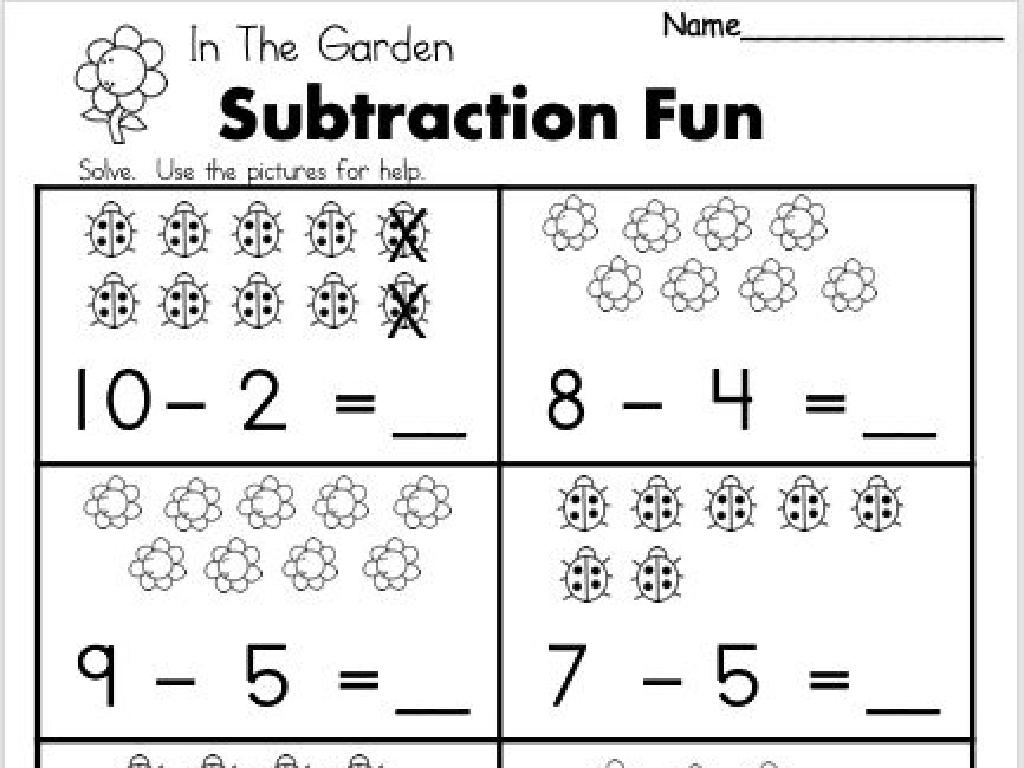Equal Quotients Of Integers
Subject: Math
Grade: Seventh grade
Topic: Operations With Integers
Please LOG IN to download the presentation. Access is available to registered users only.
View More Content
Equal Quotients of Integers
– Understanding integers
– Integers include positive, negative numbers, and zero.
– Recap: Key integer concepts
– We’ve learned about addition, subtraction, multiplication, and division of integers.
– Today’s focus: Equal quotients
– Equal quotients occur when two ratios are the same.
– Exploring quotient equality
– We’ll use examples to see how different pairs of integers can have equal quotients.
|
This slide introduces the concept of equal quotients within the broader topic of operations with integers. Begin by ensuring students have a solid understanding of what integers are, including their positive, negative nature, and zero. Recap the operations with integers covered so far, emphasizing how they apply to real-world scenarios. Introduce the concept of equal quotients, explaining that they are ratios that represent the same value. Use relatable examples to demonstrate how different integer pairs can result in the same quotient, reinforcing the idea that different problems can have similar solutions. Encourage students to think of situations where this might occur in their daily lives.
Understanding Integers
– Define integers
– Integers include whole numbers and their negatives
– Positive vs. negative integers
– Positive integers are above zero, negatives are below
– Zero: The neutral integer
– Zero is neither positive nor negative, but an integer
– Integers in math operations
|
Integers are the set of whole numbers and their opposites, including zero. They are fundamental in math, especially when dealing with real-world scenarios like banking or temperature changes. Positive integers are greater than zero and represent quantities or amounts. Negative integers are less than zero and often represent a lack or loss. Zero is a special integer that represents no quantity or a neutral position. It’s important for students to understand these concepts as they form the basis for operations with integers, such as addition, subtraction, and understanding equal quotients. Provide examples for each type of integer and encourage students to think of their own examples from everyday life.
Recap: Operations with Integers
– Review integer addition
– When adding integers, like signs sum, unlike signs subtract
– Review integer subtraction
– Subtracting integers, keep-change-change rule applies
– Review integer multiplication
– Multiplying integers, like signs positive, unlike signs negative
– Review integer division
– Dividing integers follows the same sign rules as multiplication
|
This slide is a quick recap of the basic operations with integers, aimed at reinforcing students’ understanding of adding, subtracting, multiplying, and dividing integers. Start by reviewing the rules for addition and subtraction, emphasizing the concept of absolute value and the ‘keep-change-change’ rule for subtraction. Then, move on to multiplication and division, highlighting the sign rules. Provide examples for each operation, such as -3 + 5, -7 – (-2), -4 * 6, and 12 / -3, and solve them as a class. Encourage students to explain the reasoning behind each step to solidify their comprehension. This review sets the stage for learning about equal quotients of integers.
Understanding Equal Quotients of Integers
– Define a quotient
– Result of division of two integers
– Finding integer quotients
– Divide numerator by denominator
– Simple division examples
– 8 ÷ 4 = 2 or -10 ÷ -5 = 2
– Equal quotients concept
– Quotients that are the same value
|
This slide introduces the concept of quotients in the context of integer division. A quotient is the result obtained when one integer is divided by another. To find the quotient, students should divide the numerator (the number being divided) by the denominator (the number that divides). Provide simple examples of integer division to illustrate the process. Emphasize that equal quotients are results that have the same value, even if the pairs of integers are different. Encourage students to practice with various integer pairs to become comfortable with the concept of equal quotients.
Equal Quotients of Integers
– Concept of equal quotients
– When two ratios of integers are equivalent, they have equal quotients.
– Pairs of integers, same quotient
– For example, 8/4 and 10/5 both simplify to 2.
– Equal quotients in problem-solving
– Understanding this helps simplify complex problems and find solutions.
– Practice with equal quotients
– Let’s solve problems like 16/4 and 20/5 to see they both equal 4.
|
This slide introduces the concept of equal quotients, which is fundamental in understanding how different pairs of integers can result in the same value when divided. Provide examples to illustrate this concept, such as 8 divided by 4 and 10 divided by 5, both yielding a quotient of 2. Emphasize the importance of recognizing equal quotients in simplifying expressions and solving equations, which is a key skill in algebra. Encourage students to practice with various pairs of integers to become comfortable with identifying equal quotients. This will aid in their overall mathematical problem-solving abilities.
Properties of Equal Quotients
– Commutative property in division
– Unlike addition, division is not commutative. For example, 12 ÷ 4 ` 4 ÷ 12.
– Associative property in division
– Division is not associative, meaning (a ÷ b) ÷ c ` a ÷ (b ÷ c).
– Division by zero is undefined
– Dividing any number by zero does not produce a number, hence it’s undefined.
|
This slide aims to clarify the properties of equal quotients in division. It’s crucial to highlight that division does not follow the commutative or associative properties like addition or multiplication. Provide examples to show that changing the order or grouping of numbers in division can lead to different results or make an expression undefined. Emphasize the concept that division by zero is not possible, as it does not result in a definable number. Encourage students to think of division as the process of distributing a number into equal parts and what it means when we try to distribute into ‘zero’ parts. This will help them understand why division by zero cannot be done.
Solving Problems with Equal Quotients
– Identify problems for equal quotients
– Look for division problems with equal outcomes
– Step-by-step problem-solving guide
– Follow a method: divide, compare, and verify
– Practice with example problems
– Try solving 36 ÷ 4 and 72 ÷ 8, are they equal?
– Discuss solutions and methods
|
This slide is aimed at teaching students how to recognize and solve problems that involve finding equal quotients of integers. Start by explaining what equal quotients mean and how to identify such problems. Then, provide a clear, step-by-step guide that students can follow to solve these problems, emphasizing the importance of division and comparison of results. Offer practice problems for students to apply what they’ve learned, such as dividing different numbers to see if they result in equal quotients. Encourage students to discuss their methods and solutions to reinforce their understanding. The goal is to build their confidence in working with integers and understanding the concept of equal quotients.
Class Activity: Equal Quotients Challenge
– Divide into small groups
– Receive integer division problems
– Find pairs with equal quotients
– For example, 8 ÷ 2 and 12 ÷ 3 both equal 4
– Present your findings
|
This activity is designed to help students understand that different pairs of integers can produce the same quotient. Start by dividing the class into small groups to encourage teamwork. Hand out a set of integer division problems to each group. The task for each group is to find and list different pairs of integers that, when divided, result in the same quotient. Encourage students to explore various combinations and to check their work. After the activity, have each group present their findings to the class. This will help students to see the practical application of division with integers and to recognize patterns within operations. Possible variations for different groups could include using larger integers, including negative integers, or finding real-life applications for equal quotients.
Wrapping Up: Equal Quotients of Integers
– Recap: Equal quotients concept
– Review of dividing integers with equal results
– Real-world application reminder
– Relate to dividing items or money evenly
– Homework assignment
– Solve problems on page 42, exercises 1-10
– Practice makes perfect
|
As we conclude today’s lesson, it’s important to reinforce the concept of equal quotients of integers by summarizing the key points. Remind students how these principles are used in everyday life, such as dividing items or money equally among a group. Assign homework from the textbook to provide them with the opportunity to apply what they’ve learned. Encourage them to practice diligently, as mastering this concept is crucial for their future math endeavors. The homework will help solidify their understanding and prepare them for more complex operations with integers.






